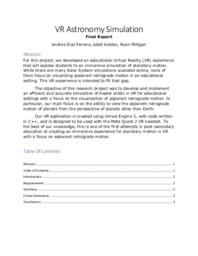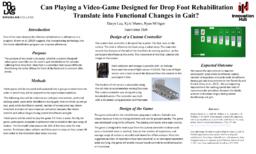Milligan, Ryan
Person Preferred Name
(none provided) (none provided)
Related Works
Content type
Digital Document
Abstract
For this project, we developed an educational Virtual Reality (VR) experience that will expose students to an immersive simulation of planetary motion. While there are many Solar System simulations available online, none of them focus on visualizing apparent retrograde motion in an educational setting. This VR experience is intended to fill that gap. The objective of this research project was to develop and implement an efficient and accurate simulation of Kepler orbits in VR for educational settings with a focus on the visualization of apparent retrograde motion. In particular, our main focus is on the ability to view the apparent retrograde motion of planets from the perspective of planets other than Earth. Our VR application is created using Unreal Engine 5, with code written in C++, and is designed to be used with the Meta Quest 2 VR headset. To the best of our knowledge, this is one of the first attempts in post-secondary education at creating an immersive experience for planetary motion in VR with a focus on apparent retrograde motion. Report submission was sponsored by Dr. Shahriar Khosravi, (Computing Science Department) for course CMPT 2367 and was presented at the New Westminster campus on April 12, 2023, for Student Research Days 2023.
Origin Information
Content type
Video
Description / Synopsis
For this project, we developed an educational Virtual Reality (VR) experience that will expose students to an immersive simulation of planetary motion. While there are many Solar System simulations available online, none of them focus on visualizing apparent retrograde motion in an educational setting. This VR experience is intended to fill that gap. The objective of this research project was to develop and implement an efficient and accurate simulation of Kepler orbits in VR for educational settings with a focus on the visualization of apparent retrograde motion. In particular, our main focus is on the ability to view the apparent retrograde motion of planets from the perspective of planets other than Earth. Our VR application is created using Unreal Engine 5, with code written in C++, and is designed to be used with the Meta Quest 2 VR headset. To the best of our knowledge, this is one of the first attempts in post-secondary education at creating an immersive experience for planetary motion in VR with a focus on apparent retrograde motion. Video submission was sponsored by Dr. Shahriar Khosravi, (Computing Science Department) for course CMPT 2367 and was presented at the New Westminster campus on April 12, 2023, for Student Research Days 2023.
Origin Information
Content type
Digital Document
Abstract
Current literature assesses effectiveness by measuring change in ankle range of motion and strength. Our study will look to assess functional changes in balance and gait performance scores and neural recruitment.
Research question: We want to find out if strength and ankle range of motion improvement in drop foot patients through a drop foot rehabilitation video game would translate to functional walking gait improvement. Research hypothesis: We hypothesize that the improvement in strength and range of motion will significantly improve participants' performance in walking gait.
After identifying that practicing ankle flexion movement in a seated position improves ankle flexion strength and range of motion in patients suffering from drop foot, we want to test if practicing ankle flexion movement will lead to improvement in walking gait. With the collaboration between engineering students and computer students at the college we have designed a functional foot pedal rehabilitation tool that uses flexion of the foot to move the cards in a solitaire game. We will be assessing gait speed and balance with the 10m walk test, timed up and go test .
We anticipate that our device improves strength and range of motion, which may potentially lead to improvement in walking gait (we are using the 10m walk test, timed up and go test to assess walking gait).
More convenient and more cost-efficient rehabilitation access for patients suffering from drop foot. Also, this will be a fun and encouraging alternative for the patients to perform the rehabilitation exercise, which will likely lead to greater adherence to the rehabilitation program.
Poster submission was sponsored by Karine Hamm, for Innovation Hub and was presented at the New Westminster campus on April 12, 2023, for Student Research Days 2023.
Origin Information



